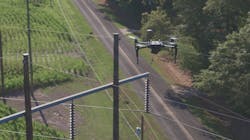Managing Assets with a Drone and Data Driven Solution
For most power co-ops, the focus on how to reduce downtime, increase worker safety and improve profitability is higher than ever. If the recent energy challenges across Texas were any indication, the utilities industry is increasingly faced with more pressures to accomplish these objectives and prioritize improved asset management.
I recently connected with Stan McHann, Senior Research Engineer at NRECA, to talk about how power co-ops can leverage drone technology and data analytics to better manage their assets and overcome common challenges, including increasing extreme weather events, difficult physical conditions and employee safety.
Here we have outlined how these challenges impact many co-ops along with how a solution that incorporates drone collection methodologies to provide more accurate and insightful data can help overcome them.
Problem: As extreme weather events become increasingly common, the rural communities served by co-ops are often disproportionately impacted by these events, including flooding, tornadoes and wildfires. Many utilities providers are undertaking storm hardening measures so that their equipment can better withstand adverse weather, including hurricane-force winds (up to 145 mph).
Solution: Drone programs are an extremely effective method for identifying areas of concern, such as rusted components or vegetation encroachment — so they can be remedied before a small problem becomes a big one and causes fires, power outages or other dangerous situations, which are more likely in inclement weather. In fact, our utilities customers have identified 45% more areas of concern on average than they had with previous inspection methodologies, which simply cannot capture everything. And one large utility provider PrecisionHawk worked with discovered that 77% of their legacy poles were predicted to fail in hurricane-force winds.
Even the best ground crew cannot see the top of a pole and Stan has found that the top-down is really where you see the weather. By utilizing a UAV to enable this angle, you see a lot more, including issues like bad bolts, loose bolts, missing bolts and loose connections.
By identifying these issues in a cost-effective, timely and scalable way — through drone inspections — co-ops can effectively harden their grid, so they are better prepared for the next adverse weather event, be it next week or next year.
Problem: Power co-ops are remote and widespread, with many serving rural areas of the United States. While approximately 97% of U.S. land area is within rural counties, just 19% of the population lives in these areas. This means a power co-op can have miles of feeder that serves only a few customers. In his work with NRECA members, Stan has found that some co-ops only have two to seven customers per mile line. To conduct inspections across these many miles of feeder, many co-ops rely on ground teams traveling from pole to pole, manually analyzing assets. This time-consuming scenario is further complicated by the fact that some distribution poles are completely inaccessible because they are in swampy areas or on fenced property. Manual inspections are also costly. It costs about US$150 and takes an hour for two line workers in a bucket truck to cover just four poles.
Solution: By replacing ground crews and bucket trucks with a drone-based solution, power co-ops can streamline inspections and get a more accurate view of the location and health of their assets. For example, during routine inspections, PrecisionHawk has discovered discrepancies in location data for 50% of poles. And while ground teams typically find that 10% of distribution poles are out of compliance, we have found that the number is actually 25-30% on average — a fairly large discrepancy.
Utilizing drones, co-ops can inventory thousands of assets across thousands of miles. They need to know exactly where their assets are because they cannot manage what they do not know they have.
Co-ops using drones can also lower costs thanks to the higher speed of drone collection compared with manual collection. In the aforementioned scenario with two line workers and a bucket truck, the inspection costs would equal US$37.50 per pole. But if these line workers used drones to perform the same task, it would take only about 15 seconds and cost about $6 per pole — a cost savings of about 84%.
Problem: Utility line work is one of the top 10 most dangerous jobs in America, with 30 to 50 of every 100,000 workers killed on the job each year. And according to Scientific American, there are 200,000 miles of high-voltage transmission lines and 5.5 million miles of distribution lines across the U.S. Each one requires a periodic inspection — that is a lot of inspection points that could put thousands of line workers performing manual inspections at risk.
Solution: With drones, ground and line crews spend fewer hazardous hours on manual inspections, decreasing the risk of accidents and injuries. The most valuable asset to any organization is its employees. Improved safety enhances employee retention, company reputation and productivity, while also helping the bottom line. In fact, according to OSHA, 60% of CFOs reported that for every dollar invested in injury prevention, the return was at least $2.
Beyond helping co-op leaders minimize job-site risk, drone programs can also help free up crews from extremely tedious tasks, such as manually analyzing every individual wire and attachment point — enabling them to perform more high-level, engaging functions.
As power co-ops continue to be laser-focused on improving asset management, drones can provide an unprecedented level of visibility and analysis. With a full data-driven solution, electric co-ops can optimize their business decisions to reduce downtime, increase safety and improve profitability.
About the Author
Robert Henley
Robert Henley is Vice President of Energy Solutions at PrecisionHawk.
